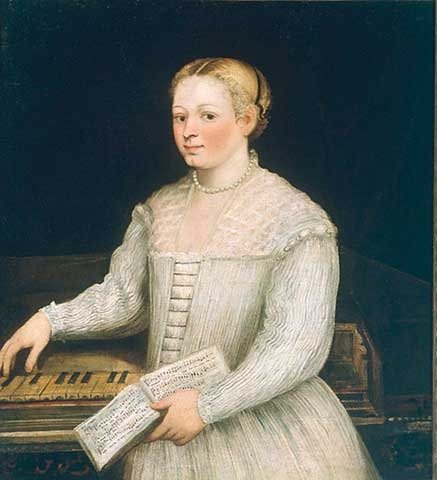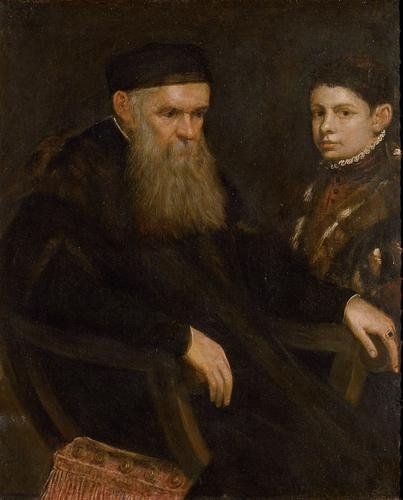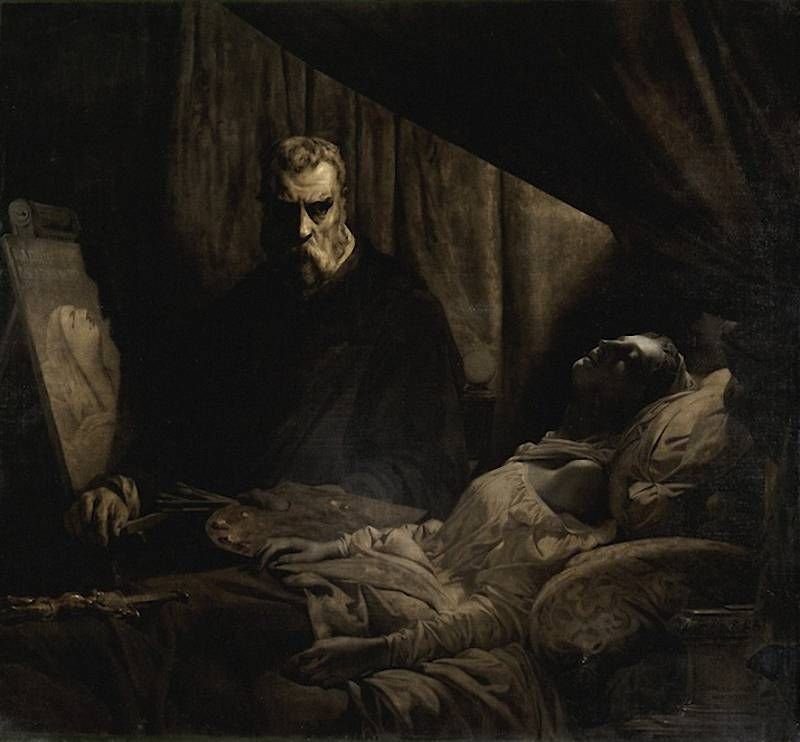Episode #103: Bits of "Breaking Barriers": Marietta Robusti (Season 12, Episode 4)
For this season of ArtCurious, I’m doing something a little bit different. I’m treating you to renditions of eight of my favorite segments from Breaking Barriers: Women Artists of Renaissance Europe, my online course found exclusively at avid.fm. Every other week through January, I’ll share selections from Breaking Barriers, and encourage you that if you like it, you can purchase the whole course. Today: Lots of women artists have gotten a head-start in their careers thanks to their families. Fathers, in particular, often led their remarkable daughters to find great success in the arts, and Marietta Robusti was no exception: her dear old dad was none other than Tintoretto, a Venetian master. But did Tintoretto’s adoration of his daughter hold her back from achieving greater heights? From Breaking Barriers: Women of Renaissance Europe, please enjoy “Marietta Robusti: Like Father, Like Daughter.”
Please SUBSCRIBE and REVIEW our show on Apple Podcasts and FOLLOW on Spotify
SPONSORS:
Betterhelp: Get 10% off your first month of counseling
The Barnes Foundation: For a limited time, get 10% off your first Barnes Class when you visit our link
Issuu: sign up for an annual premium account and get 50% off when you use promo code ARTCURIOUS
Storyworth: Save $10 off your first purchase
Nutrafol: Save $15 off your first month’s subscription, plus get free shipping on every order, with promo code ART
Want to advertise/sponsor our show?
We have partnered with AdvertiseCast to handle our advertising/sponsorship requests. They’re great to work with and will help you advertise on our show. Please email sales@advertisecast.com or click the link below to get started.
https://www.advertisecast.com/ArtCuriousPodcast
Episode Credits:
Production and Editing by Kaboonki. Theme music by Alex Davis. Logo by Dave Rainey. Additional music by Storyblocks.
ArtCurious is sponsored by Anchorlight, an interdisciplinary creative space, founded with the intent of fostering artists, designers, and craftspeople at varying stages of their development. Home to artist studios, residency opportunities, and exhibition space Anchorlight encourages mentorship and the cross-pollination of skills among creatives in the Triangle.
Recommended Reading
Please note that ArtCurious is a participant in the Bookshop.org Affiliate Program, an affiliate advertising program designed to provide a means for sites to earn advertising fees by advertising and linking to bookshop.org. This is all done at no cost to you, and serves as a means to help our show and independent bookstores. Click on the list below and thank you for your purchases!



Episode Transcript
Hi there, my lovely listeners! Welcome back to the ArtCurious podcast, where we explore the unexpected, slightly odd, and strangely wonderful in art history. If you’ve listened to our last episode, you’ll know that this season of the podcast is different. Instead of our usual spate of new episodes, I’m taking a little time off to research a new book--yay!-- so I’m sharing some slightly zhug-ed renditions of eight of my favorite segments from my audio course, Breaking Barriers: Women Artists of Renaissance Europe. Breaking Barriers is a 21-day course, meaning that you get essentially a mini-episode of ArtCurious every day for three weeks straight, and the unique opportunity to learn about some artists that you may have never heard of before--and they are likely to blow your mind, or become your next favorite artist. That’s three weeks, with every day featuring the story of a new Renaissance painter, sculptor, miniature maker-- from Sofonisba Anguissola and Marietta Robusti to lesser-known artists like Plautilla Nelli and Levina Teerlinc, this course will lead you through the lives and careers of groundbreaking women who’ve made their marks on art history. This evergreen course is all about learning for fun, no tests, no papers, no quizzes, just cool content that you can access on your own time so you can learn at your own pace. Register for the course and start learning today at Avid.fm/jennifer. In the meantime, here’s one of my favorite snippets from Breaking Barriers, all about the life and work of the tragic and talented Marietta Robusti, the daughter of the Venetian master Tintoretto. Enjoy!
Welcome back, listeners, to Breaking Barriers: Women Artists of Renaissance Europe. We’re heading back to Italy today to stop in Venice, that most serene floating city, to talk about one of art history’s most talented father-daughter pairings. While the combination of artist-and-child isn’t a rare one in art history, it’s a particularly fascinating dynamic when the parent, and not the child, is the greater name, the bigger draw. What’s it like to grow up in a household with a supremely successful parent? What’s it like to follow in that parent’s footsteps, in trying to achieve parity, or at least passability, in the same world in which he or she flourishes? It can’t have been easy for Marietta Robusti, and certainly if she was with us today, she could let us know. And that’s because her dear old dad was Tintoretto, a Venetian Renaissance painter born Jacopo Robusti, named “Tintoretto,” or “little dyer” or “the dyer’s little son,” because his father had been a fabric dyer, or tintore, in Italian. Tintoretto painted in a bold, Mannerist style and with such speed and energy that contemporaries called him “Il Furioso,” literally “The Furious One.” His brushy paintings are so suffused with excitement that you can almost feel them moving-- and while he was personally known to be a kind and agreeable soul, he also spent most of his time, quote, “thinking of ways to make himself known as the most daring painter in the world,”as his biographer, the author Carlo Ridolfi, noted. Tintoretto was daring, Tintoretto went big, both in works and in personality. Tintoretto wanted to do it all. And Tintoretto also sought to teach all of this to his eldest child, Marietta.
Born around 1560--although some historians think she may have been born in 1555--Marietta was the eldest of Tintoretto’s eight children and appears to have been born out of wedlock, with her mother unknown to historians today. Tintoretto subsequently married another woman, and it was with her that he sired his additional seven kids.
From the outset, Marietta was always identified with her father, not only as one of his assistants--and we’ll get to that bit shortly--but also in her name. As in Italian tradition and in following in her father’s footsteps, when she wasn’t being identified with her full and proper name, Marietta Robusti, she was called “La Tintoretta,” or even just “Marietta Tintoretto.” She was known by all primarily under the moniker of Tintoretto’s Daughter-- and Marietta, then, couldn’t escape her father. Although this was the case for many women in Renaissance Italy’s patriarchal society, you’ve got to wonder how this affected a girl, especially one standing right there in the shadows of her father’s massive successes.
As we’ve discussed previously, both in ArtCurious podcast episodes and in this course, Breaking Barriers, women’s access to traditional art schools, nude drawing classes, anatomical studies, and the like were thoroughly limited up until the 19th century, and even later in some locations. So it’s lucky that Marietta was raised by a father who was himself an artist, because he could directly teach her his methods and artistic techniques within the privacy of their own home, so that neither would be subjected to any criticism from the realm outside of their own halls. Tintoretto could feel safe in knowing that he didn’t have to send his daughter to be an apprentice elsewhere, potentially opening her, and himself, up for criticism, and Marietta could be comfortable getting a top-notch education with someone who she both loved and trusted innately.
From all accounts, Tintoretto essentially treated his daughter as he would have any typical apprentice, allowing her to complete sections of his own works--such as minor details and background elements--which was not only a common, hands-on way to learn the job, but to also have someone assist in a master painter’s busy schedule. In this way, father and daughter worked together, forging a symbiotic relationship, with each helping the other to become an artist in their own ways.
There’s more to Marietta’s tale, and we’ll cover the rest of it, as well as her legacy, when we come back. Thanks for listening!
Welcome back to ArtCurious.
Marietta Robusti and her father were extraordinarily close--so much so that she spent entire days exploring her city by her father’s side, with Marietta frequently donning traditional boys’ attire so that she could wander the streets of Venice with her father without having committed the social sin of basically being a girl outside of the domestic sphere--something which would have been considered uncouth. But think of what freedom that little bit of subterfuge would have allowed Marietta--and what a loving father Tintoretto would have been to go along with such a plan at a time when many Renaissance fathers might not have been inclined to do so. But the closeness between father and daughter probably had downsides, as well--both personal and professional, though the two are most certainly linked here. Marietta mostly worked as an assistant to her father in his studio, becoming especially skilled in helping him complete his many altarpieces for Venetian churches, which had a tradeoff. It meant that she didn’t have a lot of works of her own, including accepting only a scant amount of portraits on commission. Like many apprentices before and after Marietta’s time, it’s difficult to determine which works are by the apprentice--Marietta-- and which are by the master--Tintoretto, since most of their combined works are unsigned. But that doesn’t mean that Marietta has been left out of the picture entirely. In fact, things have actually improved for her over the years, with some paintings long decreed to be by Tintoretto now considered to have been pieces conceived and created by his daughter. Case in point: a painting titled Old Man and a Boy, now in Vienna, was considered to be a great work by Tintoretto until it was finally reclassified as a Marietta Robusti in the 1920s--which, to be fair, is still far earlier than most works are reattributed to women. It’s not difficult, then, to imagine that there are potentially a few other Marietta works remaining out there, masquerading under the name of her more famous father.
The only painting that historians all agree on as a truly identifiable work by Robusti is her own self-portrait, found today at the Uffizi in Florence, Italy. In the image, a blond, rosy-cheeked Robusti gently smiles at the viewer as her right hand caresses the keys of a clavichord or harpsichord-- an instrument that her father had taught her to play, and one which several of the artists we’ve already spoken of in this course--such as Sofonisba Anguissola and Lavinia Fontana--also presented themselves playing in their own self-portraits. In some ways, this image of oneself playing an instrument is the Renaissance equivalent to the Zoom bookshelf-- a way to note to viewers that these women were highly educated with a humanist background, which not only taught them about classical literature, but also in the appropriate pastimes for a well-educated lady, of which music was considered essential. Robusti, in her pale green dress and pearl necklace, looks like a Renaissance catch--beautiful, serene, smart, and talented. And such self-propagandizing probably worked, as historians believe that this was an image meant for her husband, a Venetian silversmith named Jacopo Augusta whose 1678 marriage to Marietta had been arranged by none other than Tintoretto himself.
Oh, Tintoretto. He loved his daughter so much, and wanted to give her every opportunity, to be sure. But he may have made things a little difficult for her, too, because by the time she was in her twenties, Marietta had become so skilled and respected for her painting that two members of European royalty-- King Philip II of Spain (who had been a patron of Sofonisba Anguissola’s), and the Holy Roman Emperor, Maximilian-- both sought her out as a court portraitist, though whether or not these were for long-term appointments or shorter projects is unknown. But Carlo Ridolfi, Tintoretto’s biographer and from whom we know the most details about Marietta’s life, notes that Tintoretto so adored his daughter that he couldn’t bear to have her leave Venice-and, as a result, he turned down his daughter’s incredible career offers. I have somewhat reasonable doubts about this response-- I wonder if it is a pat and easy answer and if there wasn’t something else going on here-- but I have nothing but Carlo Ridolfi’s words to back me up here. All I know is that it’s hard not to wonder how much more Marietta Robusti would have achieved, or not, if she had been allowed to take these chances. Who knows how many more easily identifiable works by Robusti would be swirling around out there.
What’s equally disheartening is that, for many years, Marietta Robusti’s life and work had only been viewed in the light of her relationship with her father--something that grew into a kind of cult admiration of Marietta as a perfect daughter and doomed heroine of the arts after her untimely death at around the age of 30 from unknown causes (though at least one historian believes she may have passed during childbirth). In the Romantic period in the 19th century, for example, her life--fueled by her early death and her father’s love---inspired mid-century painters to create their own dramatized scenes of Tintoretto at his daughter’s deathbed, where the artist may or may not have painted Marietta’s final portrait. Such images reduced Robusti’s life to that relationship, and that relationship only, of a daughter in service of her father, the great master--and for many years, this narrative stuck.
Thankfully, as with the 1920s reassessment of the Vienna painting and other potential rediscoveries, Marietta Robusti is now metaphorically stepping out of her father’s shadow. And what’s really interesting, too, is that more scholarship has been dedicated to understanding Robusti’s influence on her father’s career. In the years following Marietta’s death, Tintoretto produced far fewer paintings, and with some, it has been posited, in lesser levels of fineness and quality. Originally, historians claimed this as a reflection of a father’s grief-- doing less and with less finesse because of his emotional devastation. And while that may indeed have played a role, art historians now point to another probable cause for this downtick in production: Tintoretto no longer had Marietta at his side to bring his works that additional high level of quality and finesse. While he was always an extraordinary painter, there’s no exaggeration in the assertion that many of his best works were done in cooperation with Marietta Robusti.
I so appreciate you taking the time to listen to ArtCurious today-- thank you so much, and I hope you enjoyed learning about Marietta today as much as I did. As I mentioned at the top of the show, it would sure mean a lot to me as an independent creator if you would register for my course, Breaking Barriers: Women Artists of Renaissance Europe. It’s on sale right now, 21 days, learn on your own time and at your own pace, and it’s fun--I promise. No quizzes or grades, either, just learning for the sake of good old fashioned learning! Please register now at avid.fm/jennifer, and not only will you get the entire 21 day course, but you’ll also receive a PDF with every episode featuring the images discussed and a recommended reading list. So again, that’s Breaking Barriers: Women Artists of Renaissance Europe, available now at avid.fm/jennifer.
I’ll be back with you again in two weeks to share another story from Breaking Barriers. Thank you, again, for supporting me while I research my next project--you are awesome. Remember that we’ve got exclusive video content coming at you over on YouTube. So check us out there-the link is in the show notes on your handy-dandy podcast app right now. Stick with me, and stay curious!






